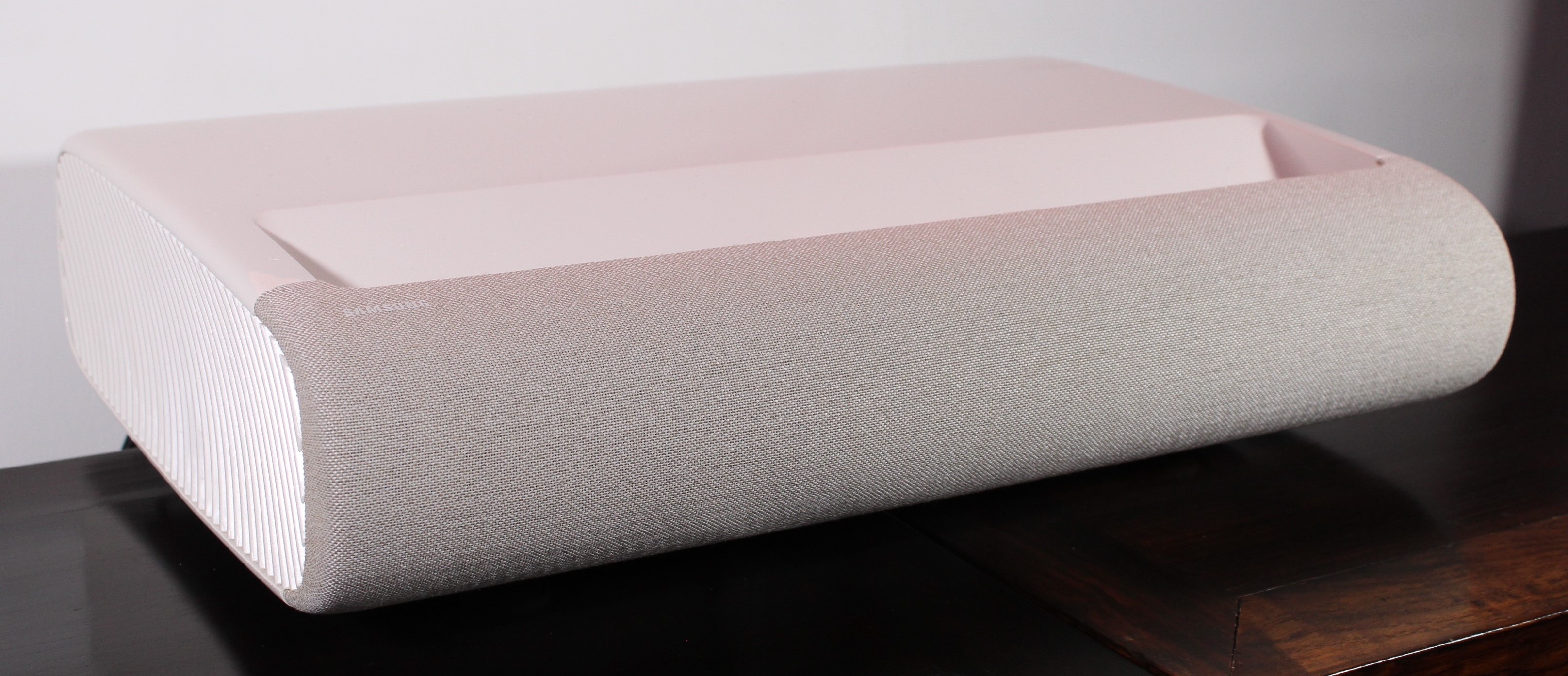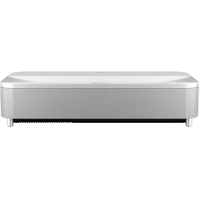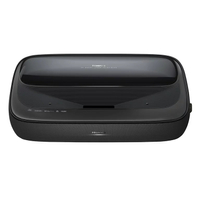TechRadar Verdict
The Samsung The Premiere 9 is an ultra short throw 4K DLP projector that employs a triple-laser light source to deliver cinematic big-screen images that are bright and vibrant. The picture accuracy is impressive, the Dolby Atmos sound is immersive, and the smart platform is comprehensive. All of which makes this capable beamer a convenient and affordable alternative to king-sized TVs.
Pros
- +
Triple-laser for big, bright pictures
- +
Vibrant and saturated colours
- +
Excellent sound quality
Cons
- -
No in-built tuners
- -
No Dolby Vision support
- -
Not ideal for serious gamers
Why you can trust TechRadar
SAMSUNG THE PREMIERE 9: two-minute review
The Samsung Premiere 9 is a highly capable example of the best ultra short throw projectors and builds on the brand’s earlier successes in this growing market segment. The key to this popularity is the triple-laser light source that uses red, green and blue lasers to generate cinematic images that are bigger than the largest TV screens. But these pictures aren’t just big, they’re bright enough to handle white walls and ambient light, while creating a huge gamut for more vibrant colours.
Samsung’s The Premiere 9 uses single-chip DLP display technology, which results in sharply defined images due to there being no alignment issues, and while not strictly native 4K the level of detail on show is often impressive. The Premiere 9 delivers superb motion handling regardless of the content – a recognised strength of DLP – but also suffers from poor black levels, which is weakness of the technology. On the plus side, a triple-laser should help reduce incidences of rainbow artifacts that can accompany DLP tech.
The Premiere 9 delivers accurate pictures thanks to the inclusion of Filmmaker Mode, while highly effective HDR tone mapping also ensures shadows are detailed and highlights free of clipping. The colour gamut covers the entire HDR standard, and beyond, so, as a result, the performance with high dynamic range is exceptional. Whether it's HDR10, HLG or HDR10+ (but not Dolby Vision, an HDR format not supported by Samsung TVs and projectors) the pictures burst off the big screen with dazzling highlights and vibrant color primaries that are a treat for the eyes.
This beamer sports an attractive lifestyle-friendly design and is easy to install and set up, while the Dolby Atmos audio system is genuinely immersive – acting more like a built-in soundbar thanks to its 2.2.2-channel speaker layout. There’s also Samsung’s AI-enhanced Object Tracking Sound processing for non-Atmos audio. There are extensive gaming features, a full smart platform with a comprehensive choice of streamers, good connectivity, and a myriad of control options.
In fact, the only real complaint is the lack of any built-in tuners, but otherwise, this capable beamer artfully blurs the line between projector and supersized TV. It does an excellent job of producing big and bright images that rival the largest examples of the best TVs, and as a result, it provides a viable, more affordable, and definitely more practical alternative, and comes highly recommended.
SAMSUNG THE PREMIERE 9 review: price and release date
- First available: September 2024
- The Premiere 9 (LPU9D): $5,999 / £5,999
Samsung’s The Premiere 9 (LPU9D) is the new range-topper in the brand’s line-up of laser-powered ultra short throw (UST) 4K HDR projectors and is available now for $5,999 / £5,999. It replaces the older The Premiere LSP9T, although this is also still available for the same price of $5,999 / £5,999. In addition, Samsung will release the mid-tier Premiere 7 in October, although pricing has yet to be announced. The Premiere 9 is not currently available in Australia.
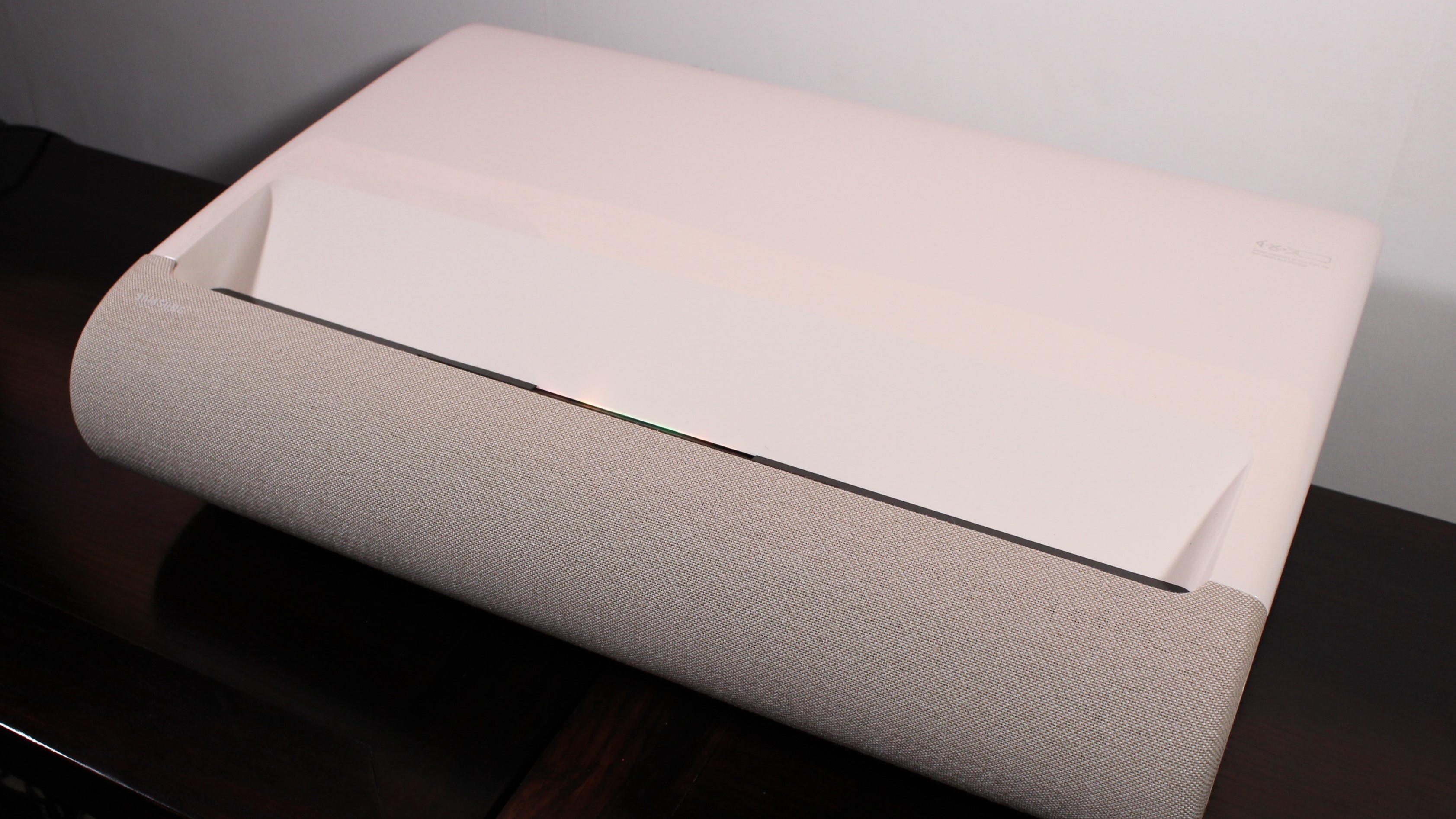
SAMSUNG THE PREMIERE 9 review: Specs
Screen sizes supported: | 100-130 inches |
Brightness (specified): | 3,450 ISO lumens |
HDR support: | HDR10+, HDR10, HLG |
Optical technology: | 3-laser DLP |
Smart TV: | Tizen |
Connections: | 3 x HDMI 2.0 (1 with eARC) , USB-A (powered), optical audio out, RS-232C, Ethernet |
Dimensions: | 5.6 x 21.7 x 15.1 inches (H x W x D) |
Weight: | 25.6 pounds |
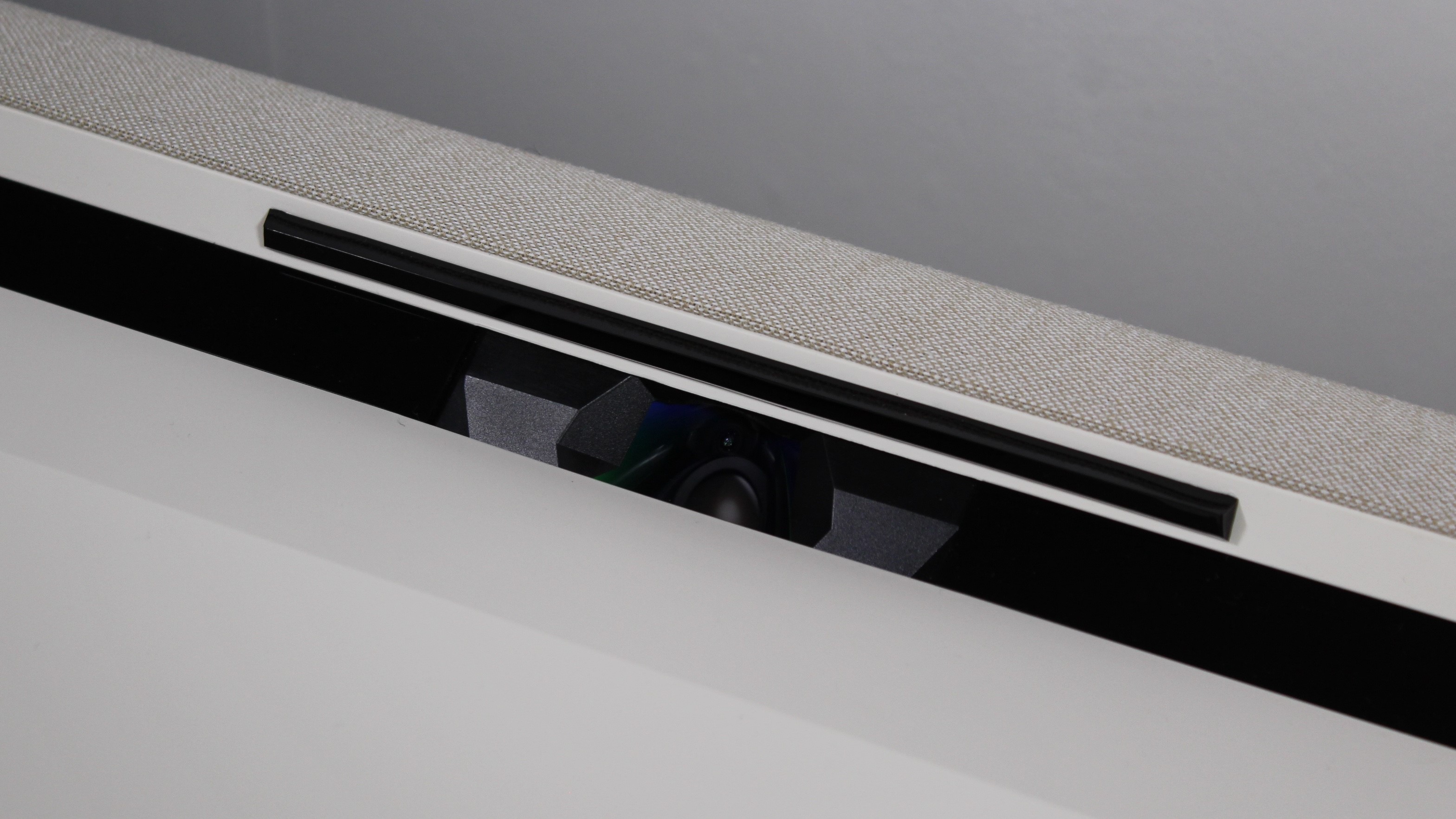
SAMSUNG THE PREMIERE 9 review: design
- Stylish and discreet design
- Excellent connectivity
- SolarCell remote control
The Premiere 9 is surprisingly stylish for a UST projector, with a curved chassis that’s well-built and finished in a neutral white. The front is covered in grey fabric, with the speakers behind, and there are air vents on either side for cooling. Despite being relatively large, this projector’s lifestyle-friendly design allows you to place it discreetly up against the wall.
Better connectivity is offered on The Premiere 9 than most other UST projectors, with three HDMI 2.0 inputs, one of which supports eARC. There’s also a USB port for multimedia playback and powering dongle-style streaming devices, an optical digital output, and an Ethernet port. The wireless connectivity includes built-in Wi-Fi 5, Bluetooth 5.2, and support for Apple AirPlay.
Samsung provides a variation of the SolarCell remote included with its current range of TVs, although the controller is styled in white to match the projector. The zapper is well-designed, intuitive to use, and comfortable to hold. There’s also a far-field microphone for the built-in voice assistants, although those wishing privacy can switch this off at the back of the projector.
- Design score: 4.5/5
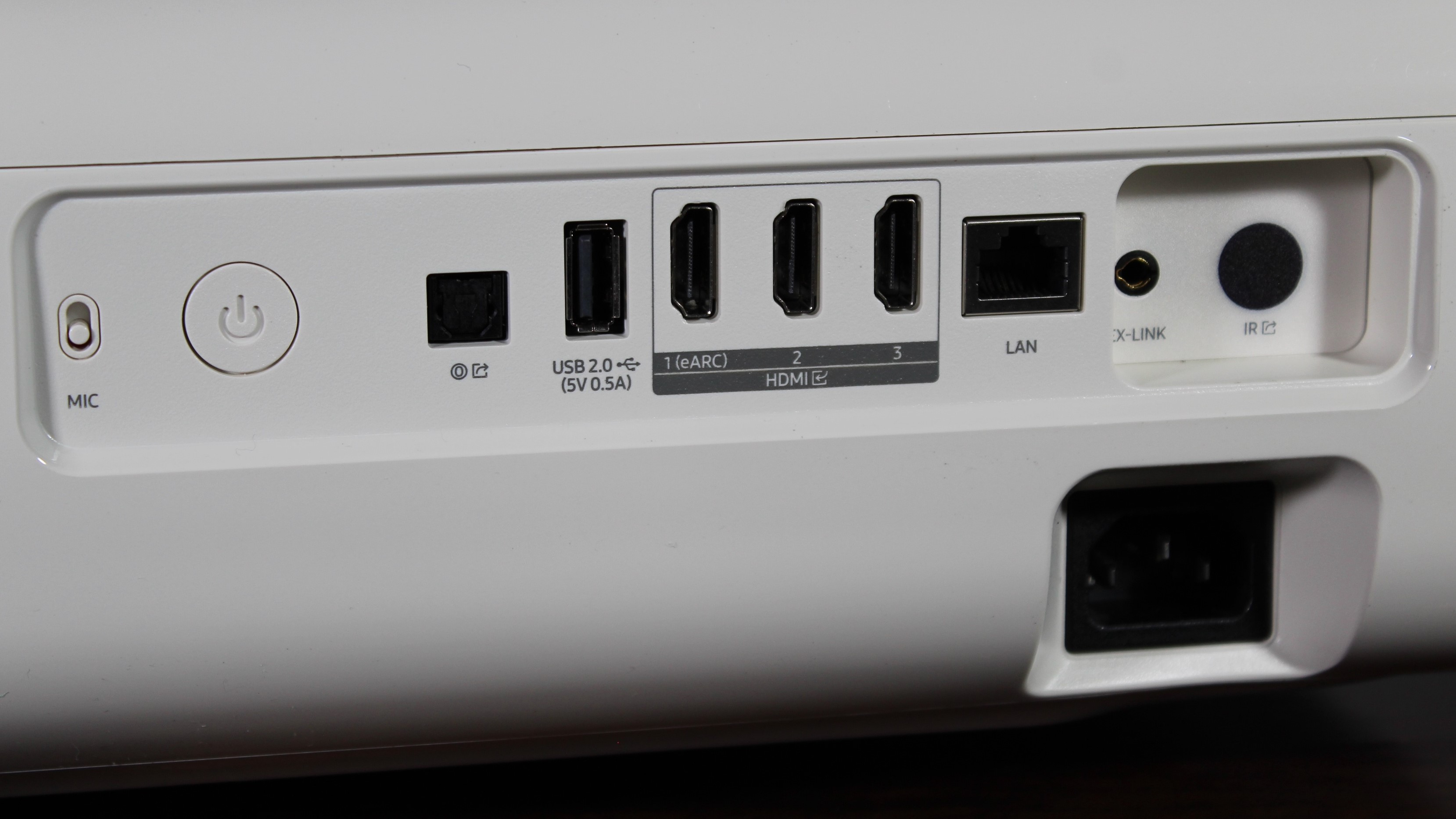
SAMSUNG THE PREMIERE 9 review: features
- Triple-laser light source
- HDR10, HLG and HDR10+ support
- 2.2.2-channel Dolby Atmos audio system
Samsung’s The Premiere 9’s headline feature is its triple-laser light source that uses red, green and blue lasers for 3,450 lumens brightness plus a wide colour gamut and 20,000-hour lifespan. This gives it an advantage over most other UST projectors and delivers sufficient luminance to handle rooms with white walls, large windows or ambient light.
As a UST beamer it’s able to project 100 inches from only 11cm (around 4 inches) , and can fill a 130-inch screen at just 24cm (9.5 inches), so even those with limited space can enjoy big screen fun. You change the image size by physically moving the projector towards or away from the wall, centre it by moving to the left or right, and level it using the adjustable feet. There are also manual controls for focusing the image.
The Premiere 9 is a single-chip DLP projector with a claimed resolution of 4K – although this is achieved by shifting pixels. It also supports most high dynamic range formats with HDR10, HLG (hybrid log-gamma), and HDR10+. Samsung doesn’t support for Dolby Vision on any of its current displays, but the RGB laser light source ensures HDR is punchy with bright and vibrant colours.
This projector sports a built-in sound system with a 2.2.2-channel speaker layout and 40W of amplification. There’s support for Samsung Object Tracking Sound (OTS) AI-enhanced audio processing, along with Dolby Atmos decoding. As a result, there’s an immersive soundstage, with clear dialogue, width at the front, some bass presence, and effectively rendered overhead sound.
There’s also support for music casting, as well as various proprietary audio features such as AI-powered Adaptive Sound Pro enhancements, Active Voice Amplifier Pro for making dialogue clearer, and Q Symphony for synching the Premiere 9 with a compatible Samsung soundbar. The latter would definitely provide benefits for those who enjoy seriously deep bass with their movies.
Once installed the setup is exactly the same as a Samsung TV, with the SmartThings app taking you through the entire process. Just follow the instructions, and within minutes you’ll have the Wi-Fi connected and all the streaming apps installed. There’s even a Vision Boost feature that uses a built-in light sensor to adjust the image brightness based on levels of ambient light in the room.
The Premiere 9 runs the full Tizen-powered smart TV system found in Samsung’s TVs, and crucially has sufficient processing power to ensure the platform is responsive. There’s smart assistance in the form of built-in Bixby and Amazon Alexa, along with a comprehensive choice of video streaming services. Where available these all offer 4K, HDR, HDR10+ and Dolby Atmos.
For gaming, there’s support for ALLM (auto low latency mode), although when in the game mode the input lag is still 53ms, which is too high for competitive gamers. In addition, the HDMI 2.0 inputs cap the frame rate at 4K/60Hz and there’s no VRR. However, the motion handling is excellent, resulting in smooth gameplay that also benefits from the immersive big-screen images.
There’s a host of other features including Samsung’s Game Hub for gaming without a console, plus a Game Bar that curates all the main settings and technical data in one place and provides access to gaming-related settings for a more personalised gaming experience. Finally, the AI Auto Game Mode allows the projector to automatically optimise settings for specific gaming genres.
This is a well-specified projector and about the only TV features missing are built-in terrestrial and satellite tuners. This is fairly common on UST projectors, probably because it makes them easier to manufacture and market globally. While you can use the TV catch-up apps instead for most shows, if you really want to watch live linear broadcasts you’ll need a set-top box of some kind.

SAMSUNG THE PREMIERE 9 review: picture and sound quality
- Sharp and detailed 4K images
- Bright and punchy HDR
- Extremely wide colour gamut
The Samsung Premiere 9 immediately impresses with its bright and punchy big screen pictures. There’s no doubt the triple-laser adds value, not just in terms of lumens but also with its wider colour gamut. The projected image is sharply defined thanks to the use of single-chip DLP, while focus and uniformity across the screen are also good, resulting in a clean and even presentation.
The out-of-the-box picture accuracy is excellent, with the white point close to the industry standard of D65, an even greyscale, and colours hitting close to their saturation targets for BT.709, but this can be improved through calibration. I was able to get a near reference-level accuracy through adjustment, and when you factor in the cost of a Premiere 9 the additional expense of a calibration is worth considering.
This accuracy also extends to HDR, with the Premiere 9 covering 100% of DCI-P3, and 92% of the even wider BT.2020 colur gamut. The previous generation of Samsung’s UST had trouble reigning in this massive native colour gamut, resulting in noticeable errors, so I was pleased to discover the accuracy of the Premiere 9 has definitely been improved with better tracking of saturation targets.
The blacks look more of a dark grey, which is fairly standard for a DLP projector, and I measured it at 1,700:1. The dynamic contrast ratio is a claimed 2,000,000:1, but this is basically achieved by turning the laser off on a black screen, so it doesn’t really reflect real-world content. There’s also a Real Depth Contrast Enhancer feature to help with contrast.
The Premiere 9 certainly has sufficient lumens to light up a 130-inch screen, even in the dimmer Filmmaker Mode, which doesn’t hit the brightness peaks of the Dynamic mode. It also means the HDR has plenty of punch and although the black levels might not be great, the tone mapping is very effective, sticking close to the PQ curve and thus avoiding unwanted crush or clipping.
The imaging is based around the Quantum Processor 4K picture engine, applying AI upscaling to lower-resolution content to take full advantage of the available pixels. The result is a finely detailed image, regardless of the original resolution, and the processing is also able to clean up the image, reducing noise or compression artefacts to deliver expertly rendered big-screen pictures.
As you’d expect from a DLP beamer, motion handling is superb, with the lightning-fast response times of the technology delivering smooth movement. Samsung includes its Motion Xcelerator technology, along with a Film mode to ensure that film-based content looks natural but is also free of judder, while fast-paced sports can enjoy smoother motion without introducing artefacts.
In standard HDR10, the brightly lit snowy landscapes of The Revenant look absolutely stunning. The same is true when watching Dune Part 2 with its desert vistas, and in both cases, these native 4K films reveal exceptional levels of detail in the sharply rendered images. Inside Out is a movie that fully utilises the wider gamut, and its deeply saturated colours really pop off the screen viewed on The Premiere 9.
Alita: Battle Angel includes HDR10+ and the Premiere 9 correctly detected the signal, applying the dynamic metadata to the tone mapping. The resulting images are well-defined, with colours that are rendered with skill, highlights that are bright, and impressive levels of detail in the shadows. There’s a lot of motion in this film as well, which was handled without judder or other artefacts.
Picture quality aside, the Premiere 9 is quiet in operation, with the noise level going from 30dB next to the chassis, down to 26dB at the main seating position. There is also an eye protection feature designed to automatically reduce the light intensity if something blocks the beam. It’s an important safety feature for anyone with small children or pets, preventing any vision damage.
- Picture quality score: 4.5/5

SAMSUNG THE PREMIERE 9 review: value
- More expensive than much of the competition
- Cheaper and more convenient compared to a supersized TV
The Samsung Premiere 9 may seem expensive at $5,999 / £5,999, and it’s certainly not cheap compared to other ultra short throw projectors, but most of them don’t use a triple-laser with all the benefits that provides. The Premiere 9 also offers great value compared to jumbo-sized TVs, with the Samsung considerably more affordable than screens with panel sizes over 100 inches. It’s also a lot easier to install – just try getting a TV with a 110-inch screen into your living room.
If you’re looking for alternatives you could consider the Epson LS800, which doesn’t support HDR10+ or Dolby Vision but is even brighter at 4,000 lumens. There’s also the Hisense PX2-Pro, which only delivers 2,400 lumens but offers support for HDR10+ and Dolby Vision. However, neither has a sound system as good as the Premiere 9 nor do they offer as many gaming features or as comprehensive a smart platform.
- Value score: 3.5/5

| Header Cell - Column 0 | Notes | Rating |
|---|---|---|
Features | Triple-laser light source with red, green and blue lasers for increased brightness, and a much wider colour gamut | 5/5 |
Design | Stylish but minimalist design, excellent build quality, good control options, three HDMI 2.0 inputs and easy installation | 5/5 |
Picture & sound quality | Bright, accurate and crisply detailed images with SDR and HDR, along with highly effective tone mapping for the latter. 2.2.2-channel system with 40W of amplification, Object Tracking Sound and Dolby Atmos ensures immersive spatial audio | 5/5 |
Value | Pricey, but worth it for the performance and features. | 4.5/5 |
Should I buy the SAMSUNG THE PREMIERE 9?

Buy it if...
You want big and bright images regardless of the room: The triple-laser light source uses individual red, green and blue lasers to deliver images that are not only cinematic but are also bright enough to handle rooms with white walls and ambient light.
You want a vibrant and punchy HDR delivery: The triple-laser doesn’t only produce big and bright pictures, but also an incredibly wide gamut that results in HDR with vibrant colours, detailed shadows, and specular highlights that pop.
You want immersive audio to match the big picture: The inclusion of a 2.2.2-channel sound system combined with Object Tracking Sound (OTS) and Dolby Vision means immersive spatial audio with sufficient scale to match the big screen images.
Don’t buy it if…
You want to veg out watching linear TV broadcasts: Since there are no built-in terrestrial or satellite tuners you’ll have to use the catch-up services to watch TV. While fine for most programming, watching linear broadcasts will require a set-top box.
You want support for Dolby Vision HDR: Unlike some UST projectors, the Premiere 9 doesn’t support Dolby Vision, although this is a result of Samsung’s corporate philosophy rather than any limitations in the Premiere 9’s capabilities.
You want a display for competitive gaming: The Premiere 9 only has HDMI 2.0 inputs, so is limited to 4K/60Hz and unable to support higher frame rates or VRR. Its input lag is also 53ms, so it isn’t an ideal projector for serious gamers.
Also consider...
| Header Cell - Column 0 | Samsung The Premiere 9 | Hisense PX2-Pro | Epson LS800 | Hisense L9G |
|---|---|---|---|---|
Price: | $5,999 | $2,999 | $3,499 | $5,499 |
Screen sizes supported: | 100-130 inches | 90 to 130 inches | Up to 150 inches | 100 inches |
Brightness (specified): | 3,450 ISO lumens | 2,400 lumens | 4,000 lumens | 3,000 lumens |
HDR support | HDR10+, HDR10, HLG | Dolby Vision, HDR10, HLG | HDR10, HLG | HDR10, HLG, Dolby Vision |
Optical technology: | 3 laser DLP | 3 laser DLP | Laser 3LCD | 3 laser DLP |
Smart TV: | Tizen | Google TV / VIDAA | Android TV | Android TV |
Connections: | 3 x HDMI 2.0 (1 with eARC) , USB-A (powered), optical audio out, RS-232C, Ethernet | 2x HDMI 2.0 (1 with ARC), HDMI 2.0 | 3x HDMI 2.0 (1 with ARC) | 2x HDMI 2.1, 1x HDMI 2.0 (with eARC), 1x RF, optical |
Hisense PX2-Pro
The Hisense PX2-Pro has around the same brightness as the BenQ but costs at least $500 less. It's not as great an option for gaming, but it does come with the Google TV smart interface for streaming and voice control.
Read our full Hisense PX2-Pro review
Epson LS800
The Epson LS800 uses a 3LCD laser light source to beam a stunningly bright 4,000 lumens image. This makes it a great option for daytime sports viewing and it also has good built-in sound.
Read our full Epson LS800 review
Hisense L9G
If you know you’re planning to get a dedicated ALR screen, the Hisense L9G, which comes with one, may make more sense. It’s less bright at 3,000 lumens, its color is also excellent, and it supports Dolby Vision. Also, its 40W sound system is a beast in its own right.
Read our full Hisense L9G review.

How I tested the SAMSUNG THE PREMIERE 9
- Reviewed in a dedicated home cinema
- Measurements taken using Calman calibration software
- Evaluated using SDR and HDR content
As with all my TV and projector reviews I use a combination of subjective viewing and objective measurements against the industry standards. For projectors, I also do all my testing in a dedicated home cinema with a completely blacked-out environment and high-quality screen. In the case of the Premiere 9, I also tested it in my lounge in order to simulate the kind of conditions for which it was primarily designed.
The subjective testing is based around watching a variety of familiar scenes, primarily sourced from 4K and 1080p Blu-rays, plus the Spears & Munsil UHD Benchmark 4K disc. These scenes have been specifically chosen to evaluate a display’s black levels, contrast performance, colour accuracy, upscaling, image processing, motion handling, and HDR tone mapping.
For the objective testing, I measured the Premiere 9’s brightness, greyscale and colour gamut in SDR, before doing the same in HDR. I also evaluated the accuracy of the HDR tone mapping, along with the colour gamut coverage for DCI-P3 and BT.2020. To do this I used a pattern generator and colour meter combined with Portrait Displays’ Calman calibration software.
I measured the Premiere 9’s input lag in milliseconds using a Leo Bodnar tester with the low latency mode switch on.
First reviewed: September, 2024

Stephen is a freelance reviewer with over ten years experience writing for all the major tech publications. As a lifelong film fan he’s embraced the evolution of home entertainment over the decades, and as a professional audio and video calibrator he’s able to keep abreast of the latest developments and innovations. When not reviewing the latest products, Stephen can be found obsessing over how to cram a bigger screen and more speakers into his own home cinema.
